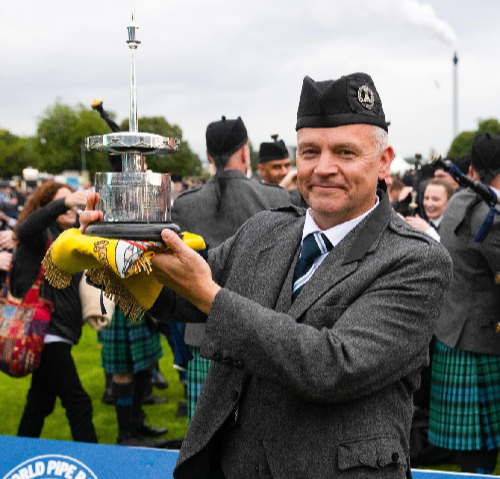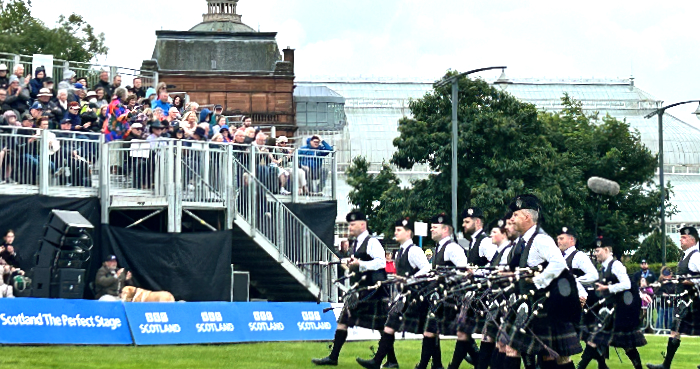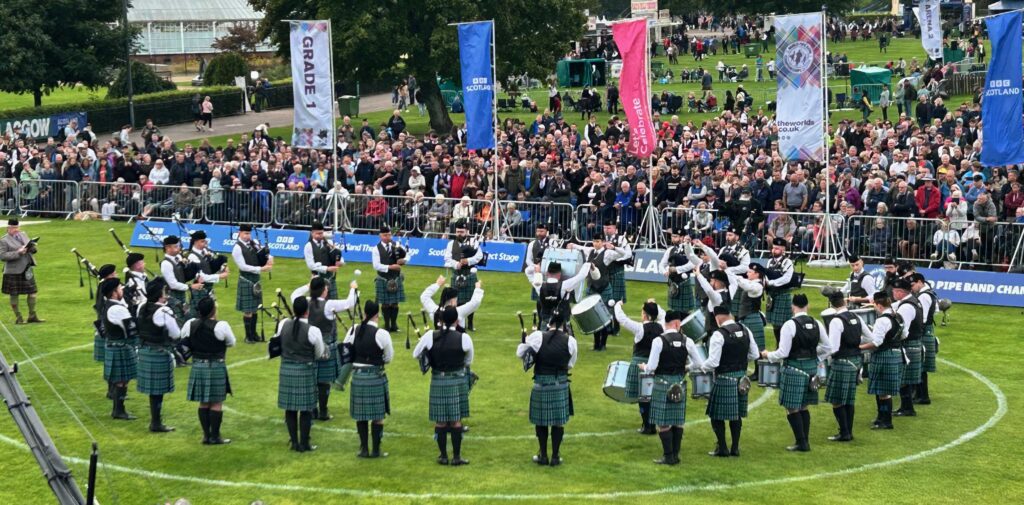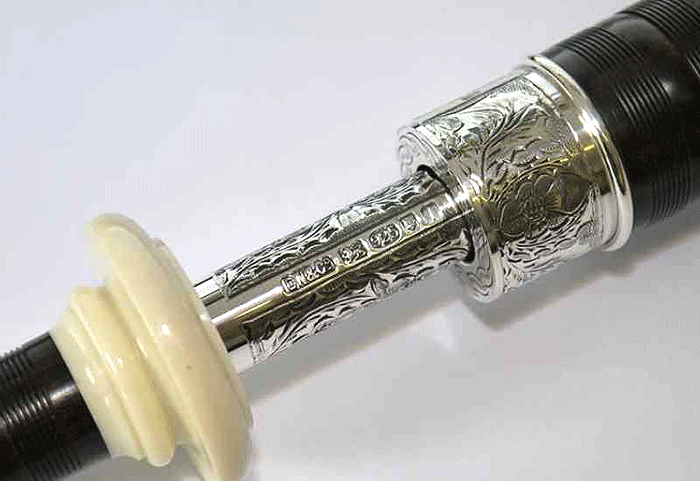
The publicity for this year’s event referred to Glasgow hosting the Championships in 1948 and continuously since 1986. The first WPBC under the then SPBA were actually held in Edinburgh’s Murrayfield Stadium in 1947, Cowal having previously been recognised as the World Championship.
For those readers interested in history, 1947 was also the year the Edinburgh International Festival was created, and the first official Tattoo was held at Edinburgh Castle in 1950.

By Alistair Aitken OBE
The Worlds this year encountered variable weather, Friday fair, but cold and windy at times and Saturday had a mixture of cloud, a cold wind and some rain. The Grade 1 arena thankfully saw the return of something like the spectator stands last seen in 2022, but only about half the height and with no seats in the middle corner (now the band exist point) so spectator seating was again much reduced.
The stand also had no roof so it was exposed to the wind and rain. The former VIP Hospitality Suite was also again missing. Like last year the other competition rings were interspersed between trade stands and band tents which made Glasgow Green rather cluttered for tuning.
Spectators in the main stand could hear the bands clearly but outwith the fenced arena it was impossible to hear the top bands with any degree of clarity unless you were standing right behind the barrier opposite the competition circle (a position claimed early by a few).
Personally I think there is scope for reducing the Grade 1 area in size without affecting the space for the competing bands and the adjudicators. The wide channel leading from the final tuning area could also be narrower to allow more space for spectators. The adjudicator tents could also have been positioned closer to the main stand, providing a shorter distance for the piping and ensemble adjudicators to have to walk at the end of each performance thus maximising the time available for completing their critiques. This would also improve the vision of standing spectators.

According to the Official Programme total band entries this year numbered 204, an increase of 14 on 2023 (146 in total in 2022). 51 of the bands were from oversea, also exceeding 2023 numbers. Taking account of qualifying heats, the total number of actual band performances would be around 280.
With these numbers the Championships are a major challenge for Glasgow City Council, Glasgow Life and Events Scotland staff, and particularly for the RSPBA’s admin staff, adjudicators, stewards and other volunteers. The large number of spectators, many of whom would be visitors to Glasgow, suggested they were enjoying the occasion.
The Grade 1 award at the World Championships is a major challenge: four separate competitions across two days, involving 16 different adjudicators. The winning band this year was Inveraray & District under Stuart Liddell MBE and Steven McWhirter. Hearty congratulations to them and their players for taking the title for the third time, having been the winners previously in 2017 and 2019. It is fair to say that this band has been the most consistent this year with 2nd, 2nd, 1st and 2nd placings respectively at the four previous Major Championships.

I very much appreciated being gifted a seat in the main stand for the MSR competition on Saturday morning. It was almost directly in front of the head of the competition circle where I could hear the balance of band sounds with the drumming projecting through the pipes. It would be unfair to comment on each of the 14 bands but the following struck me in particular:
- The MSR is traditionally the real test for competing pipe bands and all the performances I thought were of a high standard, with perhaps more variety in the tunes compared to previous years.
- Some of the drum corps in the top bands these days seem to be becoming more aggressive and dominant in their desire to demonstrate their technical ability. Winning the drumming prize has always been important for drummers, but so too should be the band balance and musical interpretation – it is after all a pipe band competition.
- Another factor in this might be that some of the bands are playing right on the edge in terms of fast tempos. While the precision and integration are invariably excellent there can be an impact on the rhythmic and musical presentation. A good example of the more traditional approach was the City of Dunedin Pipe Band which played in a more controlled manner with a nicely balanced band sound with effective expression, interpretation and musical presentation.
- For me the two standout performances on Saturday morning were Inveraray and Field Marshal Montgomery. Both performances demonstrated confidence and composure, and relaxed and effortless playing all allied to appropriate tempos and excellent collective musical effect. Not far behind were St Laurence O’Toole, Simon Fraser University, People’s Ford Boghall & Bathgate, Shotts and Dykehead, Police Scotland Fife and Scottish Power, not necessarily in that order. Some difficult decisions for the adjudicators!
I also heard the winning Juvenile performance of George Watson’s College. For me this was an excellent example of pipe band ensemble in terms of medley construction, band balance, integration of all instruments and musical effect.

I also listened to some of the bands in Heat 1 of Novice Juvenile B. I am not a fan of the standing start within the competition circle. Marching has always been an integral part of any learning process for young people, teaching them how to march in step and also to help set and maintain band tempos. The latter has traditionally always been the main purpose of the march from the starting line to the competition circle. Another common factor I noticed, even in some of the top bands, was players standing with their legs apart while competing. That was never allowed in any of the bands I played in. No doubt it will be claimed that I am just old fashioned!!

















I believe the 1957 Workd Championships were held at St Mirren Park, Love Street, Paisley
https://www.facebook.com/PaisleyHeritage/videos/world-pipe-band-championship-paisley-1957-st-mirin-fc-ground-love-street/1386118198447078/?locale=ur_PK
Just an observation. I have not been able to attend many contests over the last few years but I feel something needs to be done about the amount of deck chairs at contests. The standing spectator is getting pushed farther back. Maybe an area along the fence for deck chairs only. Two people in chairs take up the space of 5 or six standees.
Dunedin was last in the grade 1 contest so not a great example on how things should be done.